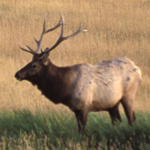| Distribution: | Dry montane steppe habitats on isolated mountains from N slopes of Kopet-Dag Mtns in S Turkmenistan (Meyer et al., 1996), mountains in E Iran in the NE (Khorassan Prov, 5 km N Kashmar, USNM) and S (Kuh-e Laleh-Zar and Kuh-e Hazar Mtns south of Kerman; Roguin, 1988), and the Hindu Kush of N Afghanistan (Ellerman, 1948; Parvan Prov, Shibar Pass, FMNH). |
| Comments: | Subgenus Microtus, arvalis species group (Pavlinov and Rossolimo, 1987, 1998; Pavlinov et al., 1995a; Zagorodnyuk, 1990). Based on banding chromosomal data, Mazurok et al. (1996b) closely allied M. transcaspicus with M. levis among species in the M. arvalis group, an association also supported by allozymic data (Mezhzherin et al., 1993) and syntheses of karyology, morphology, and hybridization (Meyer et al., 1996). Taxonomy reviewed by Malygin (1978), Meyer et al. (1981, 1996), and Meyer (1983). Roguin (1988) described kermanensis as a species, recognized as part of the M. arvalis group (Musser and Carleton, 1993; Pavlinov et al., 1995a; Zagorodnyuk, 1990). His description and specimen measurements fall within the range of variation typical of M. transcaspicus (see review of M. transcaspicus in Turkmenistan by Meyer et al., 1996), as do those large-bodied specimens of "M. arvalis" from N Afghanistan reported by Niethammer (1970) and Hassinger (1973). Microtus transcaspicus is a valid species diagnosed in part by its very large size and diploid number (adult occipitonasal length = 28-32 mm, 2n = 52) compared with the smaller-bodied M. arvalis (occipitonasal length = 22-28 mm, 2n = 46). Microtus arvalis does occur in the mountains of N Iran but has not been recorded so far east at those latitudes. |



